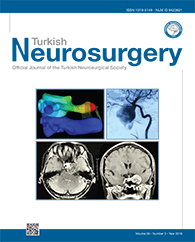2Osmangazi University, School of Medicine, Department of Neurosurgery, Eskisehir, Turkey
3Osmangazi University, School of Medicine, Department of Histology, Eskisehir, Turkey DOI : 10.5137/1019-5149.JTN.11255-14.0 AIM: Spinal cord injuries negatively affect the individuals and the life quality of their families due to neurological deficits caused by trauma. The prevalence of spinal cord injury is 15-45/1 million in the world. Caffeic acid phenethyl ester (CAPE) is the most active component of propolis and has neuroprotective, anti-oxidant and anti-apoptotic effects. Our aim was to determine the effects of CAPE on the prevention of secondary injury and to compare with methylprednisolone.
MATERIAL and METHODS: Forty rats were divided into 4 groups. The control group did not undergo surgery (Group I), only trauma group (Group II), trauma+CAPE treatment group (Group III), and trauma+methylprednisolone treatment group (Group IV). Histopathological assessment was performed with two staining methods as hematoxylin-eosin (HE) and terminal deoxynucleotidyl Transferase Biotin - dUTP Nick End Labeling (TUNEL). The groups were statistically compared.
RESULTS: The apoptotic cells decreased in treatment groups compared with the trauma. CAPE has more anti-apoptotic effect than methylprednisolone. The histological difference between the Group II, and Groups III and IV was statistically significant.
CONCLUSION: CAPE has a positive effect on spinal cord injuries by preventing apoptosis.
Keywords : Apoptosis, CAPE, Propolis, Spinal cord injury, TUNEL




